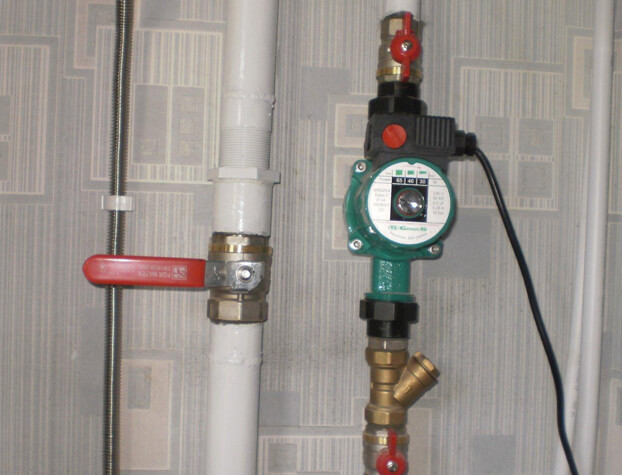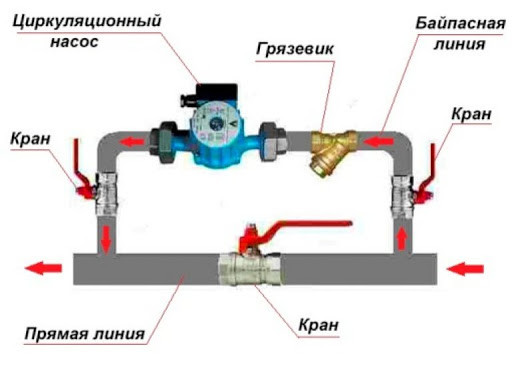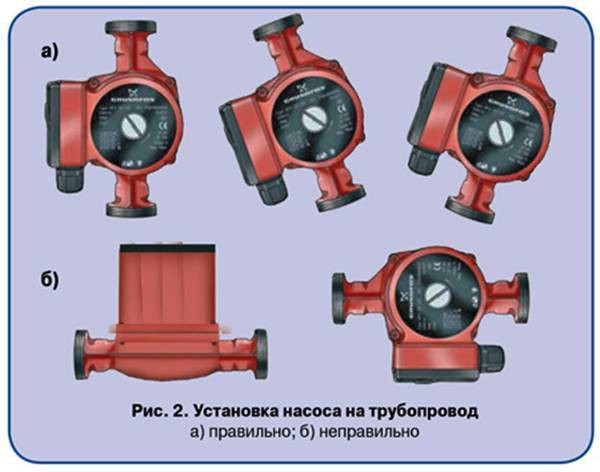Як підібрати циркуляційний насос
The most common type of room heating is radiator. It is characterized by high power, long service life, spot heating of the room and the possibility of automatic adjustment, thanks to the installation of a device that will allow the coolant to circulate inside the system. Consider how to choose the right circulation pump for heating and install it in the system.

Varieties of circulation pumps
Circulation pumps are devices consisting of two parts: a pumping part and an electric motor. With the help of the motor rotor, the impeller rotates, as a result of which water is sucked in and pressure is generated, which allows the coolant to move quickly in the pipe.
Depending on the location of the rotor, the pump can be of two types:
- Wet. This device uses the pumped liquid for lubrication. Such a pump is characterized by quiet operation and the ability to control the speed of the circulating fluid. The unit usually has three operating modes, which allows for comfortable and economical operation.
- Dry. The device consists of an electric motor equipped with an impeller. It is placed in a sealed housing located in the pumping part. The peculiarity of this type is the absence of any contact with the fluid that is pumped in the system. The dry type circulation pump is more powerful, but is characterized by increased noise during operation. Therefore, it is not suitable for installation in residential buildings.
How to choose a circulation pump for home heating?
A device suitable for installation in a residential building meets the following criteria:
Productivity. This indicator is calculated if the pump load is minimal.
- Connection diameter. Usually, the options are 25 or 32 mm.
- The height of the installation. Typically, the installation size of the pump is 130 or 180 mm.
How to calculate performance?
To make calculations to determine the performance of the pump, use the following formula:
Q = N / (t2-t1), in which
Q — performance (J);
N — boiler power (MW / h);
t1 — supply temperature (at the outlet of the boiler);
t2 — return temperature (at the inlet to the boiler);
How to calculate the power of the circulation pump?
There is such a formula for determining its value:
Q = 0.86R / TF-TR

It is not easy to understand the last formula. Therefore, experts advise taking into account that about 0.6 m of the feed height of the circulation device is taken for 10 m of a pipeline of the same diameter.

Points to consider when choosing a pump
To choose a circulation pump, you need to consider the following points:
The voltage of the mains. In residential buildings, single-phase sockets with a voltage of 220 volts are usually installed. Therefore, it is better to choose a single-phase pump here. But if the mains voltage in the house is 380 V, choose three-phase equipment.
- Maximum water heating temperature. Modern pump models are able to withstand an increase in the temperature of the coolant up to 110 degrees. Moreover, the higher the water temperature in the system, the longer the pump can operate.
- Sizes. For household consumers, the length of the pump can be 13, 15 and 15 cm. If you need to install a pump for production needs, choose a larger value.
- Maximum outlet pressure. Household appliances are limited to a pressure of up to 10 bar.
- Electrical protection. The larger the numbers near the label, the more effective the protection of the circulation pump.
How to install a circulation pump?
How to install a circulation pump in a private house? It is advised to mount it next to the boiler on the return pipe between the circuits. To avoid damage to the device and extend its service life, it is important not to make a common mistake - installing the device not in a horizontal position. The terminal box should be placed on the side or on top.

To install the pump, cap nuts are used. A strainer is placed in front of the pump. Its task is to protect the impeller from particles that can damage it. Ball valves are required before and after the pump in order to replace the pump in case of breakdown without the need to drain the coolant from the entire system.
Before starting the heating system, make sure that there is no air in it. How to remove air from the circulation pump? To do this, loosen the screw located in the central part of the device. Do this until water flows without air impurities. The same should be done several more times during the first 10-15 minutes of its operation.
There is such a formula for determining its value:
Q = 0.86R / TF-TR

It is not easy to understand the last formula. Therefore, experts advise taking into account that about 0.6 m of the feed height of the circulation device is taken for 10 m of a pipeline of the same diameter.

Points to consider when choosing a pump
To choose a circulation pump, you need to consider the following points:- The voltage of the mains. In residential buildings, single-phase sockets with a voltage of 220 volts are usually installed. Therefore, it is better to choose a single-phase pump here. But if the mains voltage in the house is 380 V, choose three-phase equipment.
- Maximum water heating temperature. Modern pump models are able to withstand an increase in the temperature of the coolant up to 110 degrees. Moreover, the higher the water temperature in the system, the longer the pump can operate.
- Sizes. For household consumers, the length of the pump can be 13, 15 and 15 cm. If you need to install a pump for production needs, choose a larger value.
- Maximum outlet pressure. Household appliances are limited to a pressure of up to 10 bar.
- Electrical protection. The larger the numbers near the label, the more effective the protection of the circulation pump.
- Sizes. For household consumers, the length of the pump can be 13, 15 and 15 cm. If you need to install a pump for production needs, choose a larger value.
How to install a circulation pump in a private house? It is advised to mount it next to the boiler on the return pipe between the circuits. To avoid damage to the device and extend its service life, it is important not to make a common mistake - installing the device not in a horizontal position. The terminal box should be placed on the side or on top.
To install the pump, cap nuts are used. A strainer is placed in front of the pump. Its task is to protect the impeller from particles that can damage it. Ball valves are required before and after the pump in order to replace the pump in case of breakdown without the need to drain the coolant from the entire system.
Before starting the heating system, make sure that there is no air in it. How to remove air from the circulation pump? To do this, loosen the screw located in the central part of the device. Do this until water flows without air impurities. The same should be done several more times during the first 10-15 minutes of its operation.